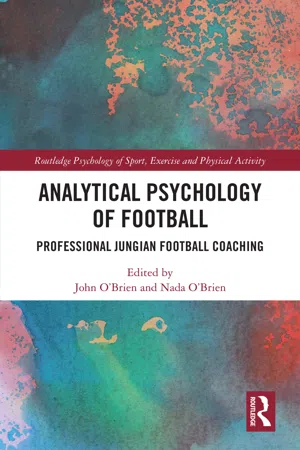
Analytical Psychology of Football
Professional Jungian Football Coaching
- 280 pages
- English
- ePUB (mobile friendly)
- Available on iOS & Android
Analytical Psychology of Football
Professional Jungian Football Coaching
About this book
Jungian psychology of football is a new and cutting edge approach being applied by Champions league teams and used in youth football training. Implications for the wider role of football organisations in society as models for the diagnosis and management of trauma and tension in our changing world are highlighted.
Analytical Psycholog y of Football: Professional Jungian Football Coaching provides for youth trainers, accessible, scientifically based tools and techniques to develop resilience and sustain motivation in grass roots and elite footballers. The values and psychological make-up of best in class international trainers are revealed, and commented upon by a Champions League manager. Theory is traced from the early history of the game through to the present day, equipping trainers with the guiding psychological concepts which are shaping the future of the sport. Case examples of how the game can support society through periods of change, and in fact, advance civilisation are described.
A Jungian appreciation of the transformational power of the football is a step forward for psychologists, and educators who wish to keep up with advancements in their professions, for football students and for trainers wishing to remain competitive.
Frequently asked questions
- Essential is ideal for learners and professionals who enjoy exploring a wide range of subjects. Access the Essential Library with 800,000+ trusted titles and best-sellers across business, personal growth, and the humanities. Includes unlimited reading time and Standard Read Aloud voice.
- Complete: Perfect for advanced learners and researchers needing full, unrestricted access. Unlock 1.4M+ books across hundreds of subjects, including academic and specialized titles. The Complete Plan also includes advanced features like Premium Read Aloud and Research Assistant.
Please note we cannot support devices running on iOS 13 and Android 7 or earlier. Learn more about using the app.
Information
Part I
Warming Up
1 What Is Football?
What Is Football?
A Global Sport
It Is What It Is
Football’s football, if that weren’t the case it wouldn’t be the game that it is.
The impulse to kick a round object has been present as long as humans have been humans. The first game of football was played when two or more people, acting on this impulse, competed in an attempt to kick a round object in one direction rather than in another.
The rules of soccer are very simple, basically it is this: if it moves, kick it. If it doesn’t move, kick it until it does (as cited in Bell 2013).
How Can We Enquire into Its Early Beginnings?
Ethology Ritual and Analogy
Rattlesnakes and Football Rattles
Definition of Analogy
…hunches guesses and intuition play an important role in scientific discovery…An intuition, like an analogy can bring together two ideas that have not previously been connected.
An analogy is a mapping of knowledge from one domain…onto another … The objects…have specific attributes and are linked by a system of relations…The strength of an analogy depends on the interdomain consistency of the relations rather than the attributes… In an analogy, the relations are shared…but the attributes are not.
Ritual and Evolution
One way or another, ritual speaks to the collective human condition. The ritual of the ball game spoke of conflict, power, cooperation, trickery, conquest, triumph, and loss. It may be that these social realities, emotionally and physically apparent in sport, informed the mythology more than the mythology informed the game.
Ritual and the Numinous
Table of contents
- Cover
- Half Title
- Series Page
- Title Page
- Copyright Page
- Dedication
- Table of Contents
- About the Contributors
- Foreword
- Part I Warming Up
- Part II First Half
- Part III Half Time
- Part IV Second Half
- Part V Match Report
- Index